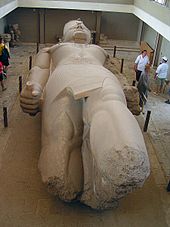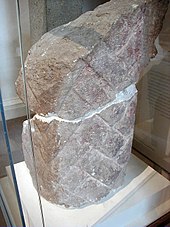Giovanni Battista Caviglia
Giovanni Battista Caviglia (* 1770 ; † 1845 ) was an Italian captain and Egyptologist . He traveled extensively throughout the Mediterranean and became known through his expeditions in Egypt, during which he discovered some well-known artifacts .
Career
During his activity as captain he met the British Egyptologist Richard William Howard Vyse and was hired by him. Together with John Shae Perring , the two began excavations at the Mykerinos pyramid , the Great Pyramid and the Chephren pyramid . Caviglia did not play a decisive role in this work, but was able to gain experience in excavations.
He started his work on the Great Sphinx of Giza around 1816 and thus began the first modern excavations . While looking for an entrance to the Sphinx, he came across the Sphinx Chapel and uncovered it completely, found two steles that were left by Ramses II after the death of his father at the Sphinx and one about 1 meter tall Fragment of the Sphinx's beard donated to the British Museum in 1818 . However, the Sphinx was not fully exposed until 1925–1926 by the French engineer Émile Baraize (1874–1952).
In 1820 Caviglia discovered the 12.88 meter long colossus of Ramses II near Memphis , at the south entrance of the Ptah Temple . In 1837 Caviglia, together with Vyse and Perring, freed the access to the Great Gallery and the descent to the Great Pyramid. This artifact was later donated to the British Museum by Mohammed Ali, but the size of the statue prevented it from being transported to England.
Web links
- A picture of the beard fragment: The British Museum
- Brief biography on the Minnesota State University website. Archived from the original on December 8, 2010 ; accessed on January 21, 2014 .
Individual evidence
- ↑ Orell Witthuhn: Giza. In: Kemet. Issue 2, 2010, p. 18.
- ↑ Julia Budka: Hut-ka-Ptah - The Temple of Ptah of Memphis. In: Kemet. Issue 2, 2002, p. 13.
| personal data | |
|---|---|
| SURNAME | Caviglia, Giovanni Battista |
| BRIEF DESCRIPTION | Italian captain and Egyptologist |
| DATE OF BIRTH | 1770 |
| DATE OF DEATH | 1845 |

